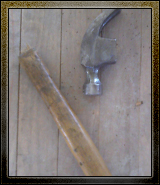
Introduction
|
 |
|
|
The hammer is a hand tool that has been around in some form or another since the dawn of human existence. There are few variations in its construction. There is usually a drop forged steel head and one of three types of handles; hickory, fiberglass, or steel with a rubber grip. Head designs include; claw, ball pein, mini-sledge, rip-claw, and drywall. The major variation between all of these hammers lies with the rear end (not the head). The head on all hammers is basically unchanged; it may be bigger or smaller but remains the same shape. A hand hammer will generally weight somewhere between 7 to 28oz (0.2 to 0.8 kg), the only exception being with the mini sledge (or drilling hammer) which generally weighs around 3 pounds (1.36 kg). Since there are so many types of hammers, and we would like to cover them all in one shot, we will assume that you will be attacking with the head (which is how the hammer is weighted to be used anyway), and we will only make mention of the advantages of the rear portion on the hammer, when necessary.
Functionality [9/10]
|
 |
|
A Wood Handled Hammer
|
As a functional weapon the hammer pulls it weight. The small head focuses the force of the blow into a small area causing a great amount of damage per swing. Since it is such a commonly used tool with so many different applications, a hammer can be found in the correct size and weight for every person, or depending on the type of job that needs to be done. Hammers are easily found at any hardware store. They are so commonly used that they can even be found at most department, and even grocery stores. They also require little to no maintenance. Hammers not only make decent weapons but are required for building and repairing fortifications and structures.
Effectiveness [8/10]
The blow from a hammer can quite easily fracture bone and cause tissue damage. Unfortunately, the hammer is only useful when used against a zombies head. The light weight of the hammer does not lend to it being very useful for breaking bone surrounded by muscle and tissue (like the ones found in your arms and legs), and since zombies don’t feel pain, tissue damage will do next to nothing for stopping them. When wielding a hammer aim for the skull. One or two good solid blows should be enough to fracture the skull and damage the brain. Some hammers, such as the drywall hammer and rip-claw hammer, have a pointed end which can be used to easily puncture the skull, and damage the brain. The hammer is an extremely close combat weapon and because of this should only be used as a last resort weapon. The overall length of a hammer ranges between 10 to 17 inches (25.4 to 43.18 cm). At this range you will be toe to toe with your undead foe, not a happy place to be.
Durability [10/10]
|
 |
|
A rare broken hammer.
(This is a very old hammer)
|
Hammers have been evolving for decades. Almost all newer hammers go through extensive testing and are made to resist thousands of blows made at full force. The only thing you would need to worry about would be the handle breaking and again many of the newer hammers have been tested and adapted to have a stronger, more durable handle, so there is little chance of this happening.
Portability [10/10]
The hammers portability should not even come into question. Most hammers weight a pound and a half or less so if you add it to your pack, you shouldn’t even notice the weight. Hammers are small compact and can easily be carried on your belt. Some pants even have a loop near their back pocket specifically made for carrying a hammer.
Practicality [7/10]
As a weapon the hammer would not be a great first choice, but when called into action the hammer will perform well. Not only as a weapon the hammer is probably more useful for building an repairing your structures and is almost an essential addition to your equipment.
|